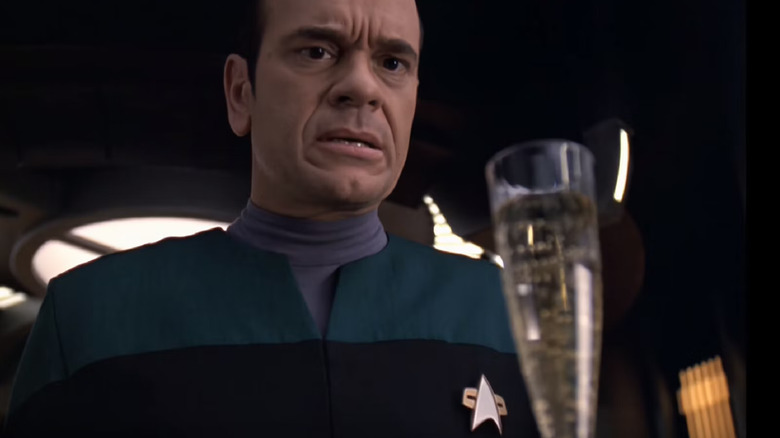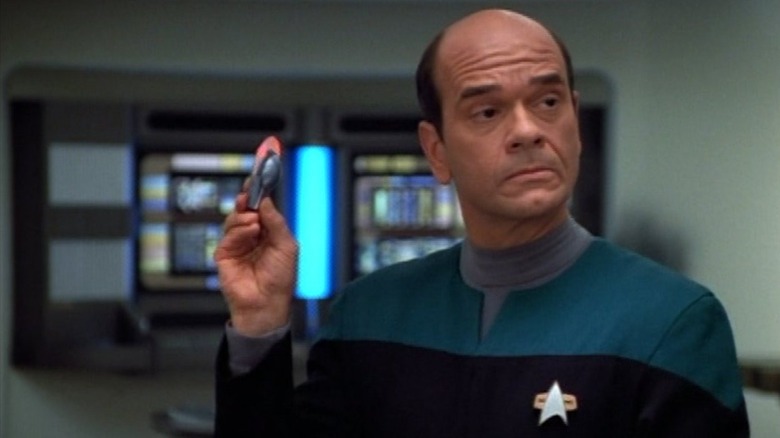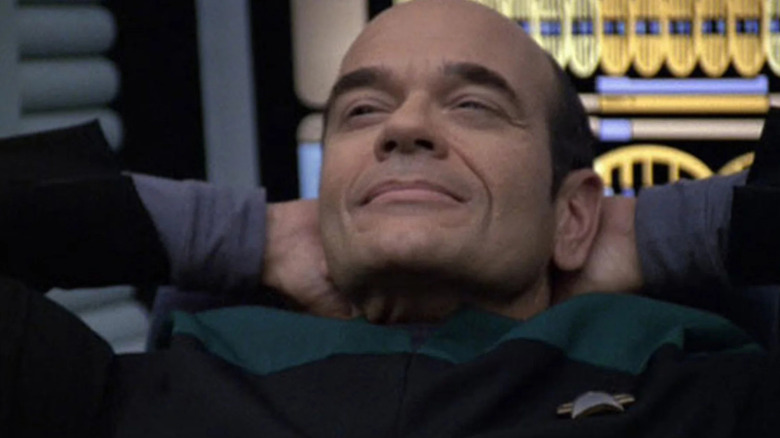Star Trek: Voyager's Robert Picardo Was Against One Of The Doctor's Biggest Changes
In the pilot episode of "Star Trek: Voyager" — called "Caretaker" (January 16, 1995) — the chief medical officer on board the U.S.S. Voyager was killed in an alien-inflicted cataclysm that swept the clear across the galaxy in a matter of moments. With the ship damaged and the medical staff wiped out, the Voyager crew had to rely on a temporary Emergency Medical Hologram to serve as the ship's main doctor.
For the first few seasons, the EMH (Robert Picardo) was snippy and impatient, having been programmed to respond only to emergencies. Using the EMH so frequently, however, caused it to develop a consciousness and a personality. Before long, the unnamed Doctor was seen as an official member of the crew.
Because he was a hologram, the Doctor was typically confined to the sickbay, where his holographic emitters were equipped. He could also be transferred directly to the ship's holodeck occasionally, but the Doctor wasn't capable of visiting other parts of the ship, nor going on away missions.
That is, until the episode "Future's End, Part II" (November 13, 1996) in the show's third season. Thanks to a time machine and some wrangling of 29th-century technology, the Doctor was equipped with a mobile emitter, a small device he wore on his arm that would project his hologram and forcefields anywhere he wanted to go. The Doctor was, from that point on, wholly unbound.
This, however, wasn't a wrinkle that Picardo approved of. In 2022, the actor spoke to StarTrek.com, and revealed that he preferred the Doctor's physical limitations. If he could walk anywhere, Picardo felt, nothing was making the character unique; he would essentially be just another human on a human-dominated starship. This might have been something the character wanted, but it wasn't something Picardo wanted.
The doctor's limitations on Star Trek: Voyager
Picardo recalls talking to one of the show's head writers and co-creators Brannon Braga about the mobile emitted shortly before it was implemented on the show ... and that he didn't like it. The actor said:
"I remember I was in Brannon Braga's office when he told me. He said, 'Your character is so popular, we need to be able to put you in more scripts, in more situations and settings. What do you think?' I said, 'I think it's a bad idea.'"
What, Picardo thought, was the point of a holographic character if he was unbound by certain practical limitations? Picardo felt that the reason the Doctor was so popular was specifically because he wasn't able to leave sickbay or a holodeck. He was a medical doctor with no physical body, making him constantly resentful of the being he had been programmed to heal and protect. Picardo admitted, however, that Braga was ultimately wise to invent the mobile emitter. He said:
"This was one time when I was clearly wrong and the producers were absolutely, 100% right. I conveyed to [Braga ...] that the character's differences define him and make him interesting to the audience. If I'm not limited to the Sickbay or the Holodeck, then I'll just be like anybody else. I'm glad they did it, as it gave me many more stories. But because the character had been kind of a break-out character ... whenever somebody plans to mess with a winning formula, I think anyone's reaction would be, 'Are we sure we want to do that?'"
The Doctor not only gained autonomy but also began to develop hobbies — he loved to sing — and a sense of social justice. The stories began to flow.
Hologram rights on Star Trek: Voyager
To that last point, the Doctor felt that the human-shaped holograms regularly used by Starfleet — they were employed in mines and other dangerous areas — were actually a new form of mechanized consciousness, and that they should have rights like flesh-and-blood citizens. Some late-series developments had the Doctor communicating with Starfleet on the matter, and winning his case.
There was a massive shift for the Doctor at the beginning of the fourth season of "Star Trek: Voyager," however. Up until then, the Doctor had been mentored by the gentle and compassionate Kes (Jennifer Lien), a character who served as the show's conscience. Picardo loved his scenes with Lien, and felt that he and Kes had developed a great working relationship. When "Voyager" was flagging in the ratings, however, the producers cut Kes out of the show and replaced her with Seven of Nine (Jeri Ryan), a former Borg clearly hired to add a cheesecake element to the show (Seven was dressed in a corset and skintight catsuit).
Picardo was concerned that the Doctor wouldn't be able to relate to Seven the way he did with Kes. He was encouraged by Braga to think of something he could form with the new character, and Picardo did have a solution:
"I gave it some thought, and I read the first script or two that they had available before we started shooting that season. I went to Brannon and suggested that we take the relationship that The Doctor had with Kes and we turn it around. So The Doctor thinks that the best person to teach Seven of Nine how to become human again is him. In other words, he's a better teacher on how to be a human being than a real human being."
It worked fine.


